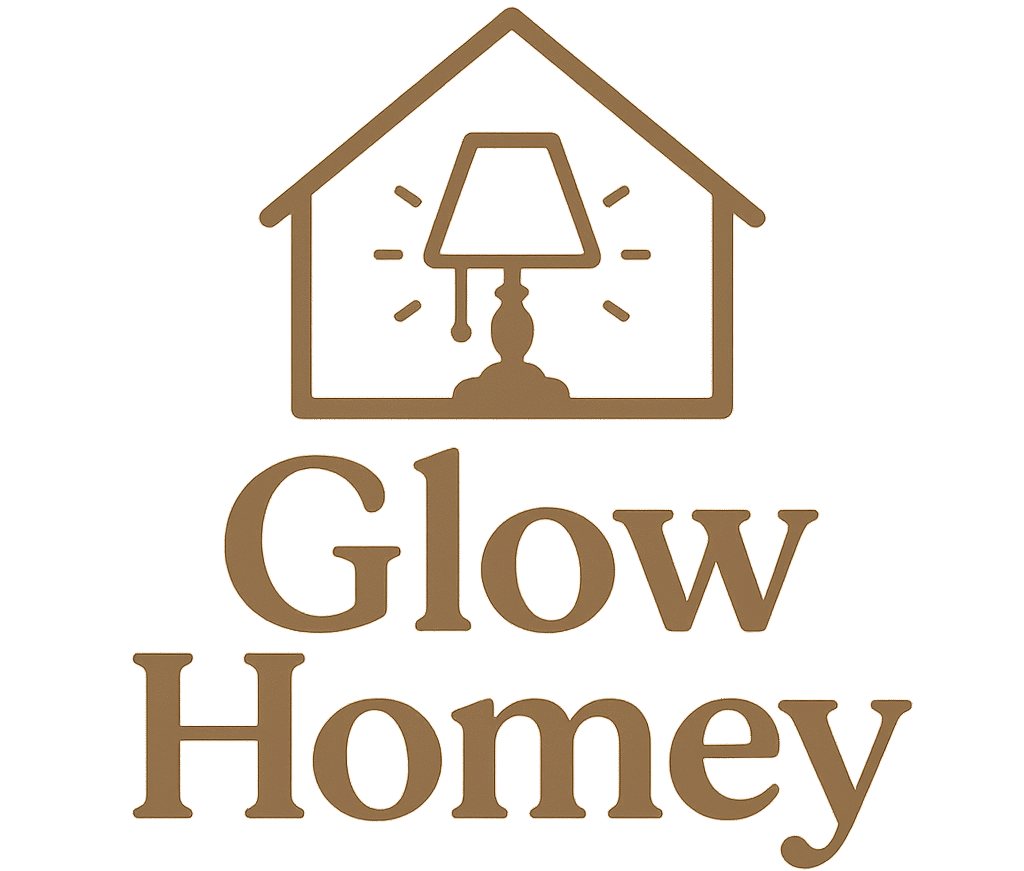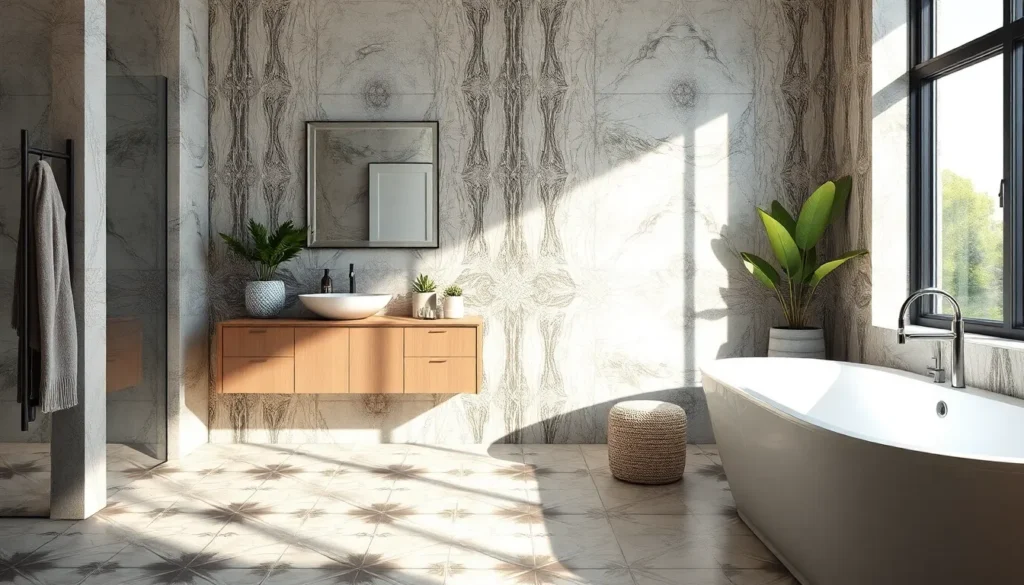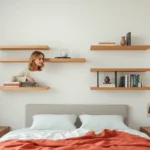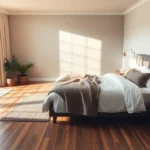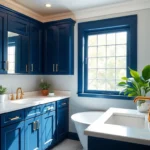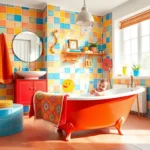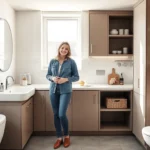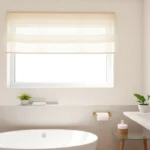We’ve all stood in our bathrooms wondering if there’s a better flooring solution than what we’re currently looking at. Whether you’re dealing with outdated tiles that scream 1980s or cheap vinyl that’s seen better days, choosing the right bathroom flooring can completely transform your space from drab to stunning.
The bathroom presents unique challenges that other rooms don’t face – constant moisture, temperature fluctuations, and heavy foot traffic. That’s why we can’t just pick any beautiful flooring option and call it a day. We need materials that’ll stand up to daily showers, splashing water, and years of use while still looking incredible.
From luxurious heated tiles to waterproof luxury vinyl planks, today’s bathroom flooring options offer the perfect blend of durability and style. We’ll explore the most popular choices that’ll not only protect your investment but also create the bathroom oasis you’ve been dreaming of.
Ceramic and Porcelain Tile Flooring Ideas
We find ceramic and porcelain tiles remain the gold standard for bathroom flooring ideas due to their exceptional water resistance and durability. These materials offer endless design possibilities while delivering the practical performance your bathroom demands.
Classic Subway Tile Patterns
Classic subway tiles create timeless elegance that never goes out of style in bathroom spaces. We recommend 3×6 inch white ceramic subway tiles for traditional looks, though modern interpretations include 4×8 inch or 2×8 inch variations. Laying patterns transform the entire aesthetic – herringbone arrangements add visual interest, while vertical stack patterns make ceilings appear higher.
Grout color selection dramatically impacts the final appearance of subway tile installations. We suggest white grout for seamless, clean lines or contrasting dark grout for bold definition between tiles. Beveled edges on subway tiles catch light beautifully and add subtle dimensional depth to bathroom walls and floors.
Large Format Porcelain Planks
Large format porcelain planks deliver stunning wood looks without moisture concerns that plague natural materials. We typically see these tiles measuring 6×36 inches, 8×48 inches, or even 12×48 inches for dramatic contemporary appeal. Wood grain textures feel remarkably realistic underfoot while providing superior slip resistance compared to traditional smooth tiles.
Installation becomes faster with fewer grout lines when using large format planks in bathroom applications. We recommend rectified edges for tighter grout joints that create seamless transitions between planks. Popular finishes include weathered oak, rustic hickory, and modern gray wash effects that complement various bathroom design themes.
Mosaic Tile Designs
Mosaic tiles offer incredible versatility for creating custom bathroom flooring patterns and artistic focal points. We see popular options including 1×1 inch squares, hexagonal shapes, penny rounds, and intricate geometric patterns. Natural stone mosaics like marble or travertine provide luxury appeal, while glass mosaics reflect light to brighten smaller bathroom spaces.
Sheet mounted mosaics simplify installation while allowing for complex designs that would be difficult to achieve with individual tiles. We recommend using contrasting grout colors to highlight mosaic patterns or matching grout tones for subtle, cohesive looks. Anti slip treatments on mosaic surfaces ensure safety in wet bathroom environments without compromising visual appeal.
Natural Stone Bathroom Flooring Options
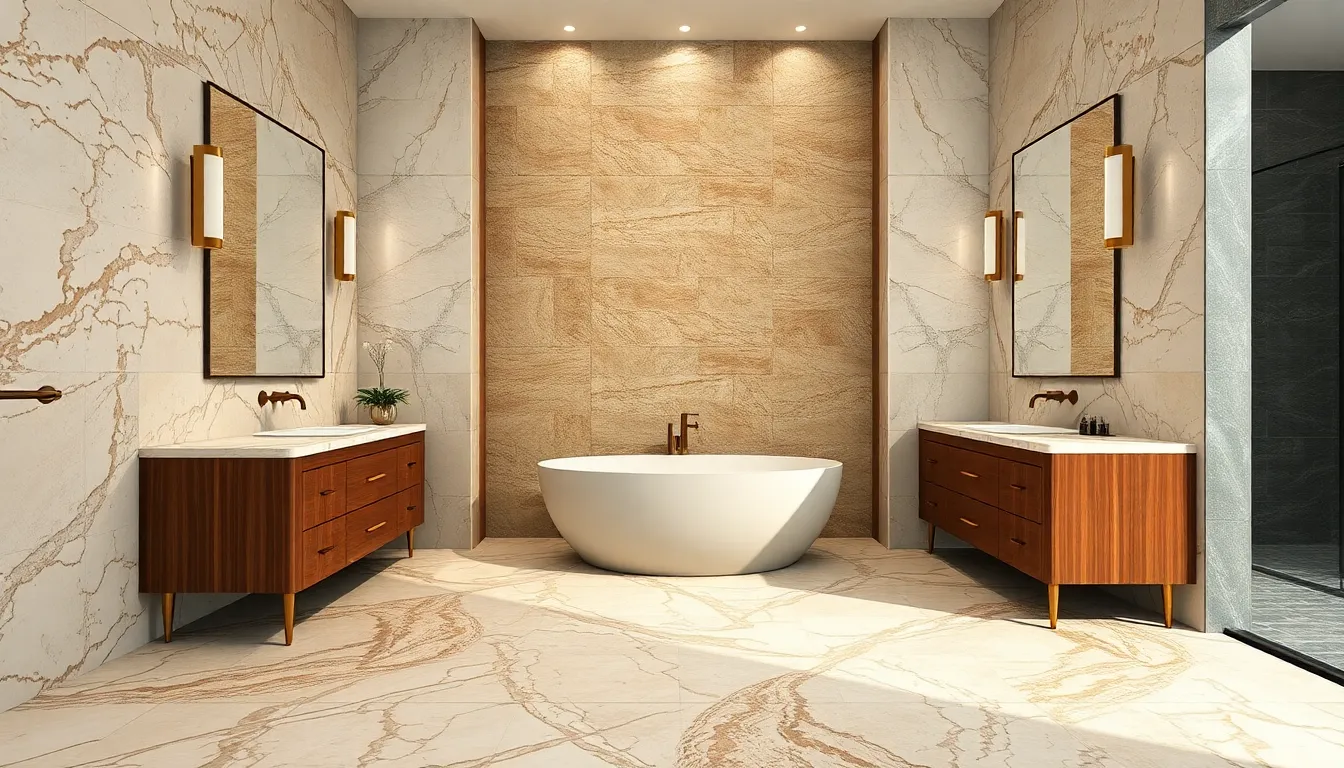
Natural stone brings timeless luxury to bathroom spaces with unmatched beauty and character. We’ll explore three popular natural stone options that can transform your bathroom into an elegant retreat.
Marble Flooring Elegance
Marble flooring creates the ultimate sophisticated bathroom experience with its stunning veining patterns and lustrous finish. We love how marble instantly elevates any bathroom design from ordinary to extraordinary, making it a favorite choice for luxury renovations.
Porosity becomes the main consideration when selecting marble for bathroom floors since this natural stone requires regular sealing to prevent stains and water damage. We recommend sealing marble floors every 6-12 months to maintain their pristine appearance and protect against moisture infiltration.
Popular marble varieties like Carrara, Calacatta, and Emperador each offer distinct color palettes and veining characteristics. Carrara provides subtle gray veining on white backgrounds, while Calacatta features more dramatic and bold veining patterns that create striking focal points.
Slate Tile Durability
Slate tile delivers exceptional durability and moisture resistance that makes it perfect for high traffic bathroom areas. We appreciate slate’s natural slip resistance properties, which provide added safety in wet environments without compromising style.
Color variety sets slate apart from other natural stones, offering options from deep charcoal and forest green to warm burgundy and golden tones. We often recommend slate for contemporary bathroom designs where earthy textures and rich colors create spa-like atmospheres.
Texture options range from smooth honed finishes to naturally cleft surfaces that add visual depth and tactile interest. Installation becomes straightforward with slate since its durability allows for thinner tiles that reduce weight while maintaining strength.
Travertine Stone Appeal
Travertine stone provides warm, earthy aesthetics with its naturally pitted surface that creates unique texture and visual interest. We find travertine particularly appealing for Mediterranean and rustic bathroom styles where its honey and beige tones complement wooden vanities and bronze fixtures.
Medium absorbency rates make travertine more manageable than highly porous stones while still requiring proper sealing for bathroom applications. We suggest filled travertine for bathroom floors since the smooth surface reduces maintenance while preserving the stone’s natural character.
Easy maintenance compared to marble and limestone makes travertine an attractive middle ground option for homeowners seeking natural stone beauty without intensive upkeep requirements. Regular cleaning with pH neutral stone cleaners keeps travertine floors looking their best for years.
Luxury Vinyl Plank Flooring Solutions
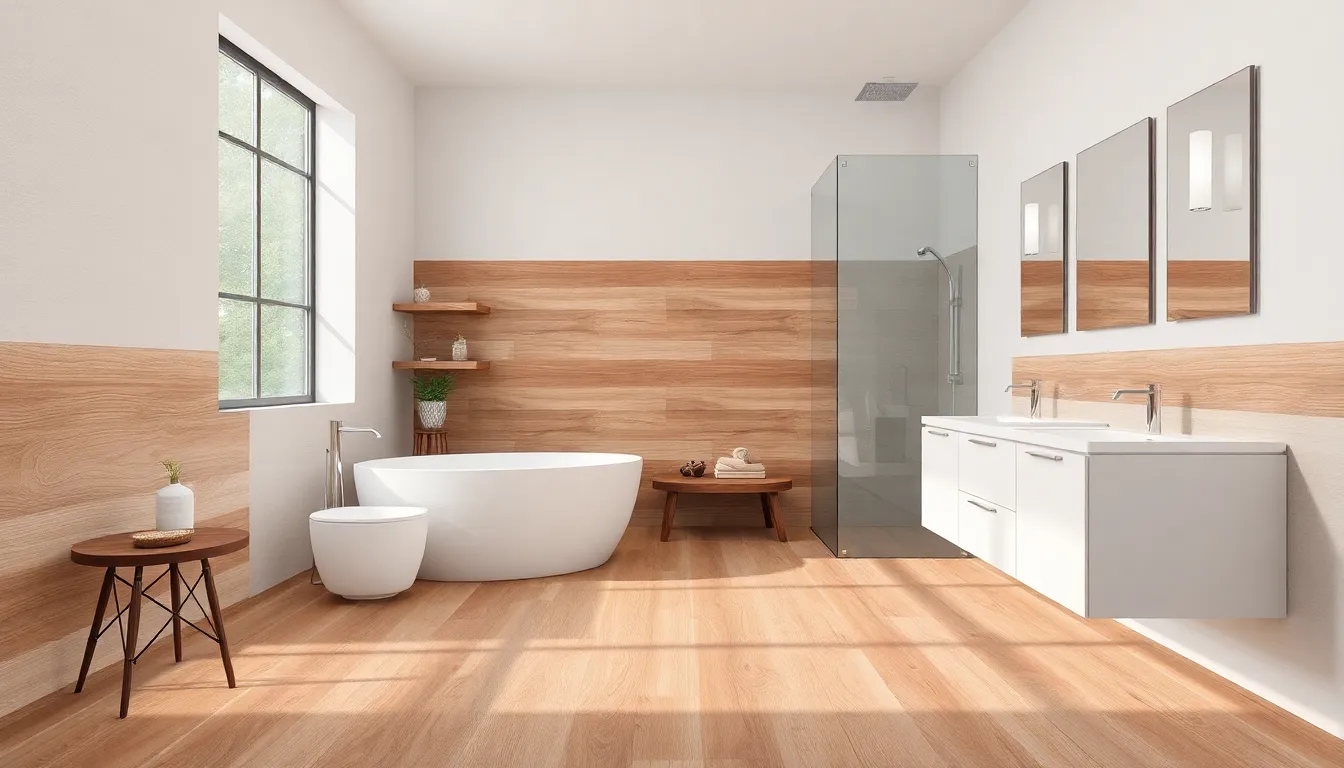
We’ve found that luxury vinyl plank (LVP) flooring has emerged as one of the most practical bathroom flooring answers for modern homeowners. This versatile flooring option combines durability with style while addressing the unique challenges that bathroom environments present.
Waterproof LVP Benefits
Waterproof luxury vinyl plank flooring delivers exceptional moisture resistance that makes it ideal for bathroom installations. The waterproof core prevents warping, swelling, or peeling when exposed to high humidity and water spills that are common in bathroom settings. We appreciate how this moisture barrier helps prevent mold and mildew growth, maintaining a healthier indoor environment for families.
Key Performance Benefits:
| Feature | Benefit |
|---|---|
| Moisture Resistance | Withstands water spills and humidity |
| Mold Prevention | Creates barrier against moisture buildup |
| Noise Reduction | Multi-layer construction absorbs sound |
| Easy Installation | Click-lock systems allow DIY installation |
Sound absorption is another advantage we notice with luxury vinyl flooring, as the multi-layer construction helps create a quieter bathroom space. Installation becomes straightforward with click-lock or adhesive backing systems that allow for DIY projects without professional help.
Wood-Look Vinyl Styles
Wood-look vinyl planks offer the aesthetic appeal of natural hardwood without the maintenance concerns or moisture vulnerability. These styles replicate the grain patterns, textures, and color variations found in popular wood species like oak, maple, and hickory. We recommend wood-look LVP for homeowners who want the warmth and character of wood flooring in their bathroom space.
Modern manufacturing techniques create realistic wood appearances that are virtually indistinguishable from genuine hardwood. Plank widths range from traditional narrow boards to contemporary wide planks that can make smaller bathrooms appear larger. Color options span from light blonde tones to rich dark browns, allowing us to match any design preference or existing décor.
Stone-Look Vinyl Options
Stone-look vinyl provides the sophisticated appearance of natural stone or ceramic tile without the associated costs and maintenance requirements. These options replicate marble veining, slate textures, and travertine patterns with remarkable accuracy. We find that stone-look LVP offers the perfect solution for achieving a luxurious aesthetic while maintaining the practical benefits of vinyl flooring.
Popular stone-look styles include marble with dramatic veining, slate with natural texture variations, and limestone with subtle color gradations. Tile sizes range from small format mosaics to large format planks that minimize grout lines and create a seamless appearance. Installation remains simple compared to actual stone, while the waterproof properties eliminate concerns about sealing or special maintenance that natural stone requires.
Engineered Hardwood Flooring Alternatives
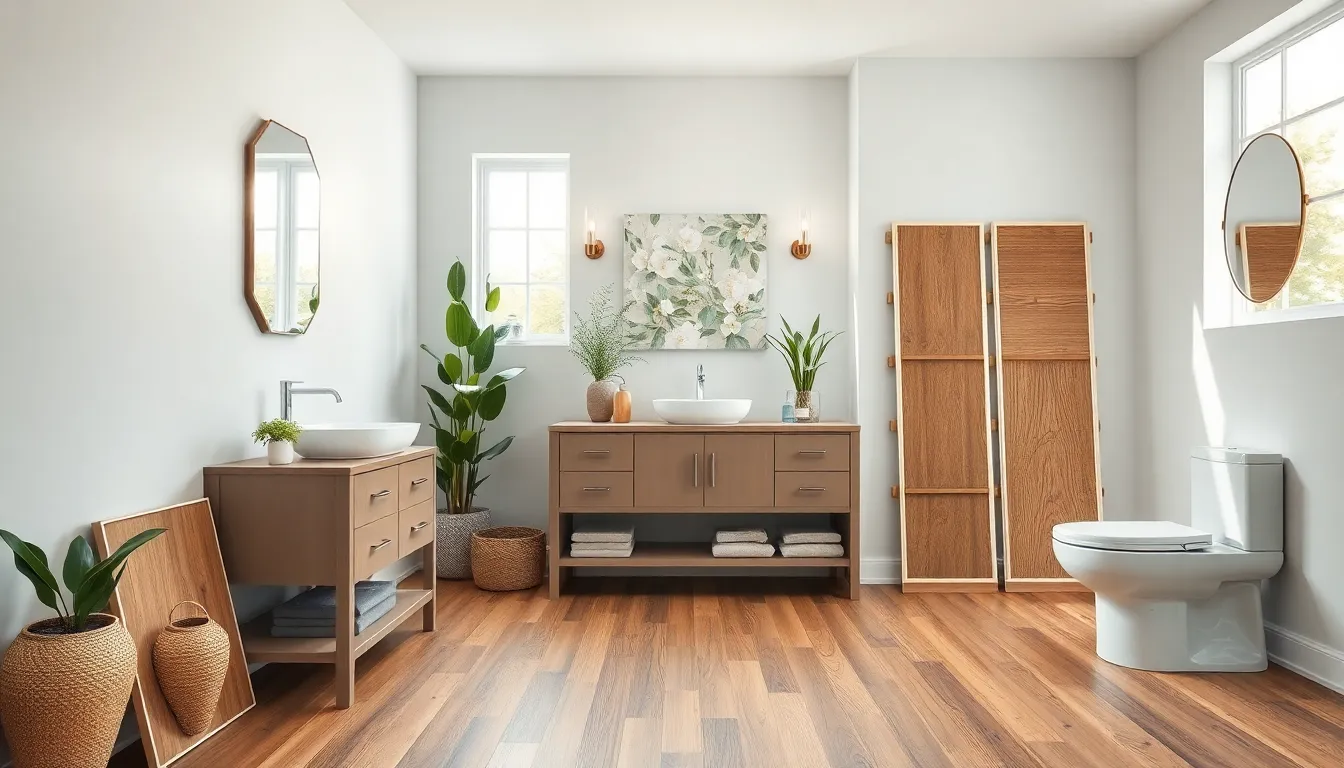
While hardwood flooring brings warmth and beauty to bathrooms, we recognize that moisture concerns often make homeowners hesitant to choose this option. Several innovative alternatives deliver the aesthetic appeal of wood while addressing durability and water resistance challenges.
Bamboo Flooring Sustainability
Bamboo flooring stands out as an exceptionally sustainable choice due to its rapid growth rate and minimal environmental impact. We appreciate how this renewable resource regenerates much faster than traditional hardwood species, making it an eco-conscious option for environmentally aware homeowners. Durability plays a crucial role in bamboo’s bathroom suitability, as it naturally resists moisture better than many conventional wood options. Installation becomes straightforward with bamboo’s dimensional stability, reducing concerns about warping in humid bathroom environments.
Cork Flooring Comfort
Cork flooring delivers unmatched comfort and warmth underfoot, creating a spa-like experience in bathroom spaces. We find its natural cushioning properties particularly beneficial for homeowners who spend extended time on bathroom floors during daily routines. Sustainability remains a key advantage since cork harvesting doesn’t harm the cork oak trees, allowing them to continue producing cork for decades. Sound absorption qualities make cork flooring ideal for multi-story homes where noise reduction matters. Insulation properties help maintain comfortable temperatures year-round, contributing to energy efficiency in bathroom spaces.
Water-Resistant Wood Options
Engineered hardwood offers superior dimensional stability compared to solid hardwood, making it a more viable bathroom flooring choice. We recommend this option because its layered construction resists moisture-related expansion and contraction better than traditional planks. Waterproof hardwood represents the latest advancement in flooring technology, combining authentic wood beauty with vinyl-like durability and moisture protection. Modern manufacturing processes create these innovative products that withstand bathroom humidity without compromising aesthetic appeal.
Exact hardwood species provide enhanced water resistance when properly sealed and maintained. White oak demonstrates exceptional moisture tolerance due to its tight grain structure and natural durability. Hickory offers remarkable hardness and water resistance, making it suitable for high-traffic bathroom areas. Maple provides consistent performance with proper sealing, though all these species require strong protective finishes to maximize their moisture resistance in bathroom environments.
Modern Concrete Flooring Designs
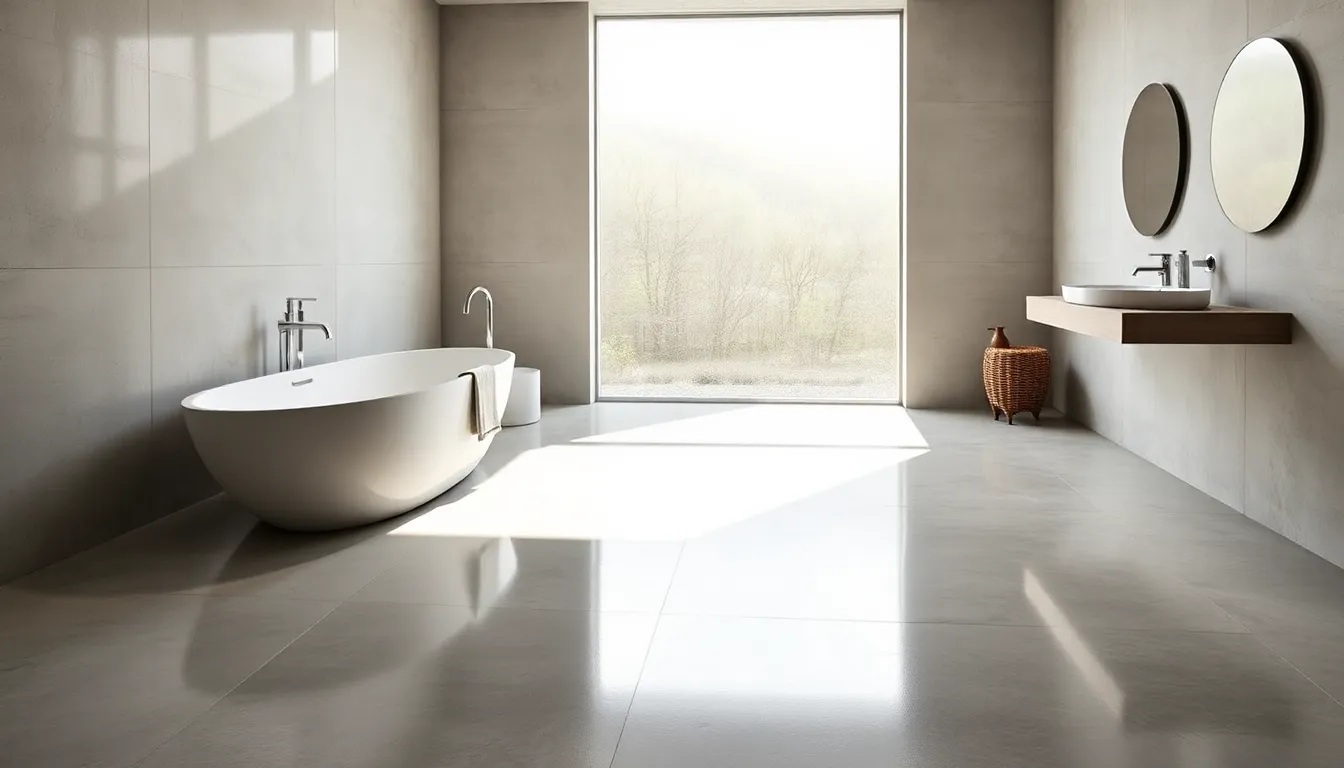
Concrete floors bring an industrial aesthetic to contemporary bathrooms while offering exceptional durability. These surfaces create a sleek foundation that complements modern fixtures and minimalist design elements.
Polished Concrete Finishes
Polished concrete transforms ordinary floors into sophisticated surfaces through mechanical grinding and polishing techniques. We achieve high gloss finishes that enhance the concrete’s natural beauty while dramatically improving its durability and stain resistance. This process creates a mirror-like surface that reflects light beautifully throughout your bathroom space.
Maintenance becomes effortless with polished concrete since the sealed surface resists moisture penetration and bacterial growth. We recommend this finish for homeowners seeking a luxurious appearance without the upkeep requirements of natural stone. The grinding process also eliminates surface imperfections and creates a perfectly smooth walking surface that’s comfortable underfoot.
Professional installation ensures optimal results since the polishing process requires specialized equipment and expertise. We typically see installation costs ranging from $8 to $15 per square foot depending on the desired level of polish and surface preparation needed.
Stamped Concrete Patterns
Stamped concrete allows us to replicate expensive materials like natural stone, brick, or tile at a fraction of the cost. Fresh concrete receives pattern impressions before it sets, creating realistic textures that fool the eye. We can choose from hundreds of pattern options including slate, cobblestone, wood plank, and geometric designs.
Color integration happens during the stamping process using release agents and integral color additives. This technique produces consistent coloration throughout the concrete thickness, preventing the chipping and fading issues common with surface-applied colors. We often combine multiple colors to create authentic-looking variations that mimic natural materials.
Design flexibility makes stamped concrete perfect for creating custom bathroom floors that match your unique vision. Border patterns can define spaces while accent designs add visual interest around fixtures or in shower areas. Installation requires precise timing since patterns must be applied while the concrete remains workable.
Epoxy Coated Concrete Surfaces
Epoxy coatings provide an additional protective layer that transforms concrete into a chemical-resistant, stain-proof surface. We apply these coatings directly over prepared concrete to create floors that withstand heavy foot traffic and bathroom chemicals without deterioration. The coating bonds permanently with the concrete substrate, creating a seamless, non-porous surface.
Customization options include metallic finishes, decorative flakes, and solid colors that complement any bathroom design scheme. We can create everything from subtle earth tones to bold statement floors using specialized epoxy formulations. Anti-slip additives ensure safety in wet conditions while maintaining the coating’s aesthetic appeal.
Installation typically takes 3-5 days including surface preparation, primer application, and multiple epoxy coats. We recommend professional installation since proper surface preparation and coating application are critical for long-term performance. Properly installed epoxy floors can last 15-20 years with minimal maintenance requirements.
Budget-Friendly Bathroom Flooring Ideas
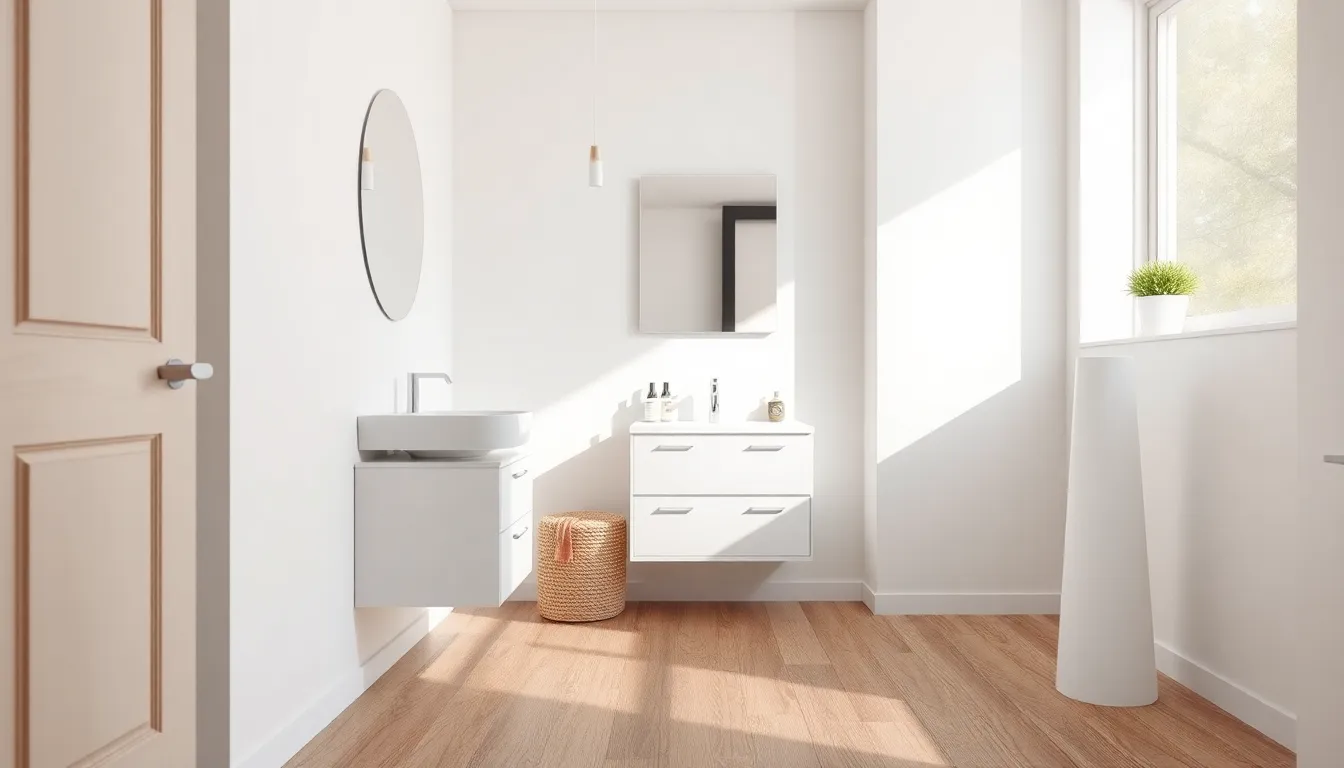
We understand that creating a beautiful bathroom doesn’t have to drain your savings account. Smart homeowners can achieve stunning results with affordable flooring options that deliver both style and functionality.
Laminate Flooring Answers
Laminate flooring transforms your bathroom space without the hefty price tag of traditional hardwood or ceramic tiles. Modern laminate technologies offer exceptional durability and water resistance, making them suitable for bathroom environments where moisture is a constant concern.
Installation becomes a weekend DIY project with click-lock systems that eliminate the need for professional contractors. We recommend choosing laminate with AC4 or AC5 ratings for superior wear resistance in high-traffic bathroom areas.
Design versatility shines through realistic wood-grain patterns and stone textures that fool even discerning eyes. Popular finishes include weathered oak, reclaimed pine, and marble-look surfaces that complement various bathroom styles from rustic farmhouse to contemporary minimalist.
Maintenance requires only regular sweeping and damp mopping, saving both time and money on specialized cleaning products. Quality laminate flooring typically costs between $2-6 per square foot, making it an attractive alternative to premium materials.
Vinyl Sheet Flooring
Vinyl sheet flooring delivers unmatched water resistance at an incredibly affordable price point. This seamless flooring option eliminates grout lines where moisture and bacteria can accumulate, creating a healthier bathroom environment.
Installation flexibility allows for covering existing floors in many cases, reducing demolition costs and project timelines. Professional installation typically takes just one day for average-sized bathrooms, minimizing disruption to your daily routine.
Pattern variety includes convincing wood planks, natural stone textures, and geometric designs that suit any decorating preference. Recent innovations in photographic printing create remarkably realistic surfaces that rival expensive natural materials.
Comfort underfoot surpasses hard tile surfaces, providing cushioning that reduces fatigue during daily grooming routines. Premium vinyl sheets range from $1-4 per square foot, making them one of the most economical flooring choices available.
Peel-and-Stick Tile Options
Peel-and-stick tiles revolutionize bathroom renovations with their simple adhesive backing system. These waterproof tiles require no special tools or professional installation, making them perfect for budget-conscious DIY enthusiasts.
Creative patterns emerge when mixing different tile designs, colors, and sizes to create custom looks. Popular combinations include alternating neutral and accent colors or creating border designs around vanity areas and shower entrances.
Removal remains hassle-free when you’re ready for future updates, as most quality adhesive tiles come off cleanly without damaging subfloors. This flexibility makes them ideal for rental properties or temporary design answers.
Cost effectiveness reaches new heights with prices ranging from $0.50-3 per square foot, allowing complete bathroom makeovers for under $200. Quality options now include realistic stone textures, subway tile patterns, and trendy geometric shapes that mirror expensive designer tiles.
Small Bathroom Flooring Strategies
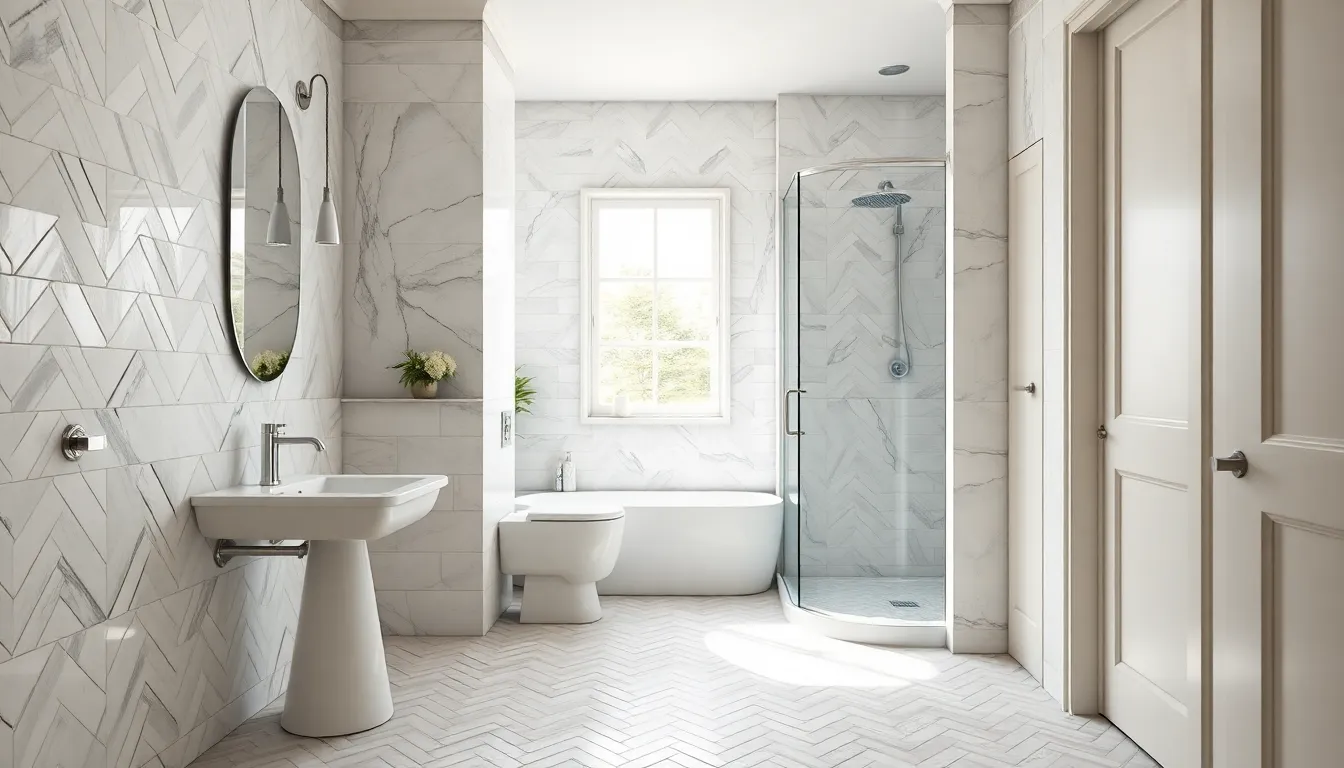
Small bathrooms present unique design challenges, but we can maximize space through strategic flooring choices. Smart flooring decisions create visual expansion while maintaining the functionality we need in these compact spaces.
Light-Colored Flooring Choices
Light colored flooring transforms cramped bathrooms by reflecting natural light and creating an airy atmosphere. We recommend ceramic or porcelain tiles as the most practical option since they offer exceptional durability and moisture resistance in various light shades. Natural stone materials like marble or travertine add sophisticated elegance while providing the bright tones that make spaces feel larger.
Glass tiles deliver a modern aesthetic with their light reflecting properties, though they require more careful maintenance than ceramic alternatives. Porcelain options now replicate the look of natural materials without the associated upkeep, making them ideal for busy households. Stone choices bring unique character through natural veining and texture variations that add visual interest without overwhelming small spaces.
| Flooring Type | Price Range | Durability | Maintenance Level |
|---|---|---|---|
| Ceramic/Porcelain | $2-8/sq ft | High | Low |
| Natural Stone | $8-20/sq ft | High | Medium-High |
| Glass Tiles | $5-15/sq ft | Medium-High | High |
Diagonal Installation Patterns
Diagonal tile installation creates the illusion of expanded space by drawing the eye along longer sight lines. Chevron patterns require tiles to be angled and meet at precise points, creating ever-changing visual movement that makes rooms appear larger than their actual dimensions. Herringbone patterns connect tiles at 90 degree angles, producing a classic look that adds sophistication while improving perceived space.
Both patterns work exceptionally well with rectangular tiles, as the angular placement tricks the eye into seeing expanded dimensions. We find that chevron installations create more dramatic visual impact, while herringbone offers timeless appeal that complements various design styles. Smaller tiles in diagonal patterns multiply the space expanding effect, making 12×24 inch planks particularly effective for compact bathrooms.
Professional installation ensures pattern alignment remains consistent throughout the space, preventing visual disruptions that could make the room feel smaller. DIY enthusiasts should start patterns from the room’s center point to maintain symmetry and maximize the space improving benefits.
Continuous Flooring Flow
Continuous flooring from adjacent rooms into the bathroom eliminates visual barriers that make small spaces feel confined. We achieve this seamless transition by using the same flooring material throughout connected areas, creating an uninterrupted visual plane that expands perceived space. Seamless transitions require careful attention to threshold details and height matching between different areas.
Waterproof luxury vinyl planks excel at creating continuous flow since they handle moisture while matching hardwood floors in main living areas. Large format tiles work similarly well, especially when we extend the same material from hallways into powder rooms. Color coordination becomes crucial when materials differ slightly, as even small variations can create visual breaks that segment the space.
Successful continuous flow requires planning during the design phase to ensure proper subfloor preparation and moisture barriers where needed. We recommend consulting flooring professionals when transitioning between different substrate types to maintain structural integrity while achieving the desired visual continuity.
High-Traffic Bathroom Flooring Materials
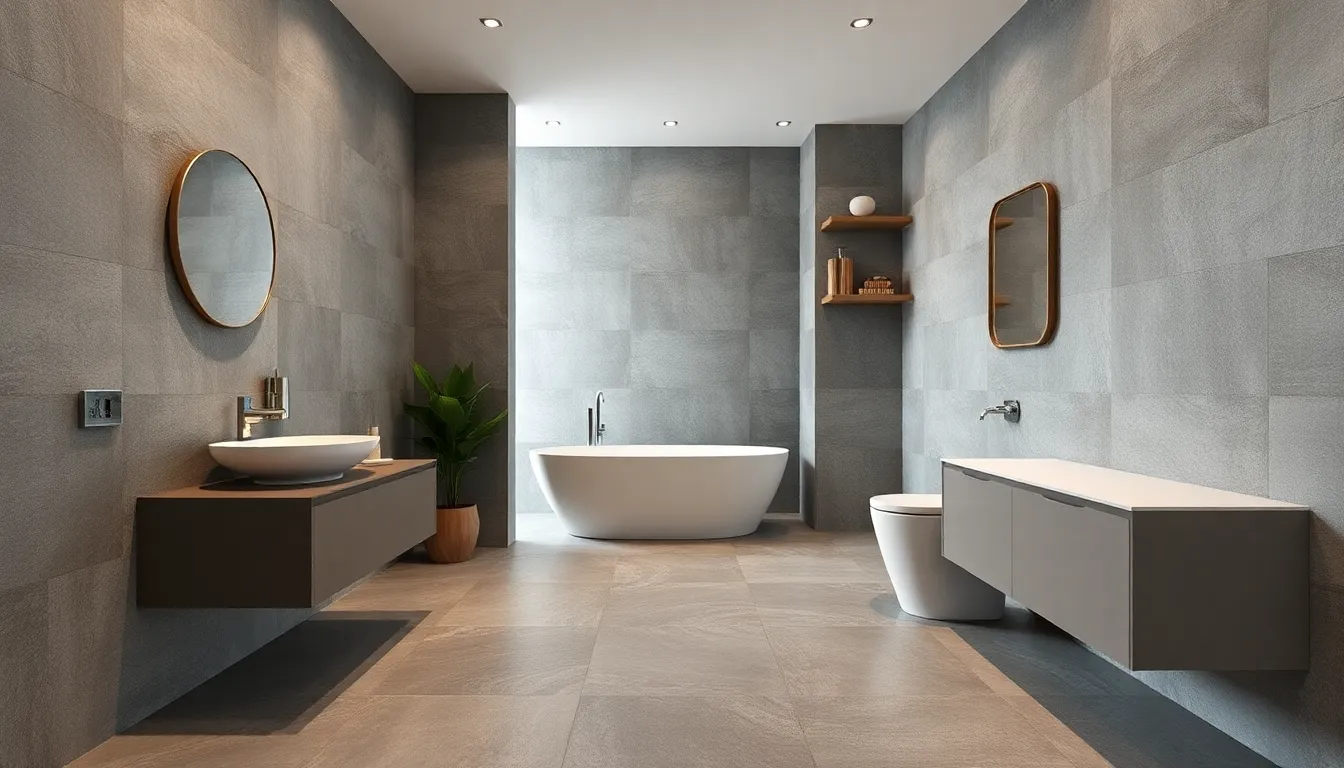
When we’re dealing with bathrooms that see constant use, choosing the right flooring materials becomes crucial for long-term durability and safety.
Non-Slip Surface Options
Textured finishes provide the highest level of slip resistance in wet bathroom conditions. We recommend these matte or textured surfaces because they significantly reduce the risk of accidents when water accumulates on the floor. Porcelain and ceramic tiles with textured surfaces offer excellent grip while maintaining their stylish appearance.
Matte finish tiles deliver superior safety without compromising on aesthetics. These surfaces create micro-textures that enhance traction, making them ideal for shower areas and high-moisture zones. We’ve found that matte finishes also hide water spots better than glossy alternatives.
Non-slip mats and adhesive strips serve as additional safety measures in critical areas. Installing these products in shower floors and transition zones provides extra grip where water tends to pool. We suggest combining these accessories with naturally slip-resistant flooring materials for maximum protection.
Scratch-Resistant Finishes
Porcelain tiles offer exceptional scratch resistance that makes them perfect for high-traffic bathroom environments. Their dense composition and hard surface can withstand daily wear from foot traffic, dropped items, and cleaning equipment. We’ve observed that porcelain maintains its appearance even after years of heavy use.
Ceramic tiles provide reliable scratch resistance at a more affordable price point. These durable surfaces resist damage from typical bathroom activities while offering easy replacement options if needed. Quality ceramic tiles can handle the demands of busy family bathrooms without showing important wear patterns.
Enhanced vinyl flooring delivers improved scratch resistance compared to traditional flooring materials. While not as scratch-resistant as tile options, modern vinyl products feature protective wear layers that resist damage from daily use. We recommend looking for commercial-grade vinyl options for maximum durability.
Easy-Maintenance Materials
Porcelain and ceramic tiles require minimal maintenance due to their impermeable surfaces that resist stains and water damage. These materials need only regular cleaning with standard bathroom cleaners to maintain their appearance. We appreciate how these tiles don’t absorb moisture, preventing mold and mildew growth.
Water-resistant vinyl flooring offers hassle-free maintenance that busy homeowners appreciate. These surfaces clean easily with damp mopping and resist moisture penetration that can cause warping or damage. Many vinyl options feature antimicrobial properties that help maintain a hygienic bathroom environment.
Sealed natural stone provides easy maintenance when properly treated with quality sealers. Regular resealing protects the stone from stains and water damage while preserving its natural beauty. We recommend following manufacturer guidelines for sealing frequency to maintain optimal protection and appearance.
Eco-Friendly Bathroom Flooring Ideas
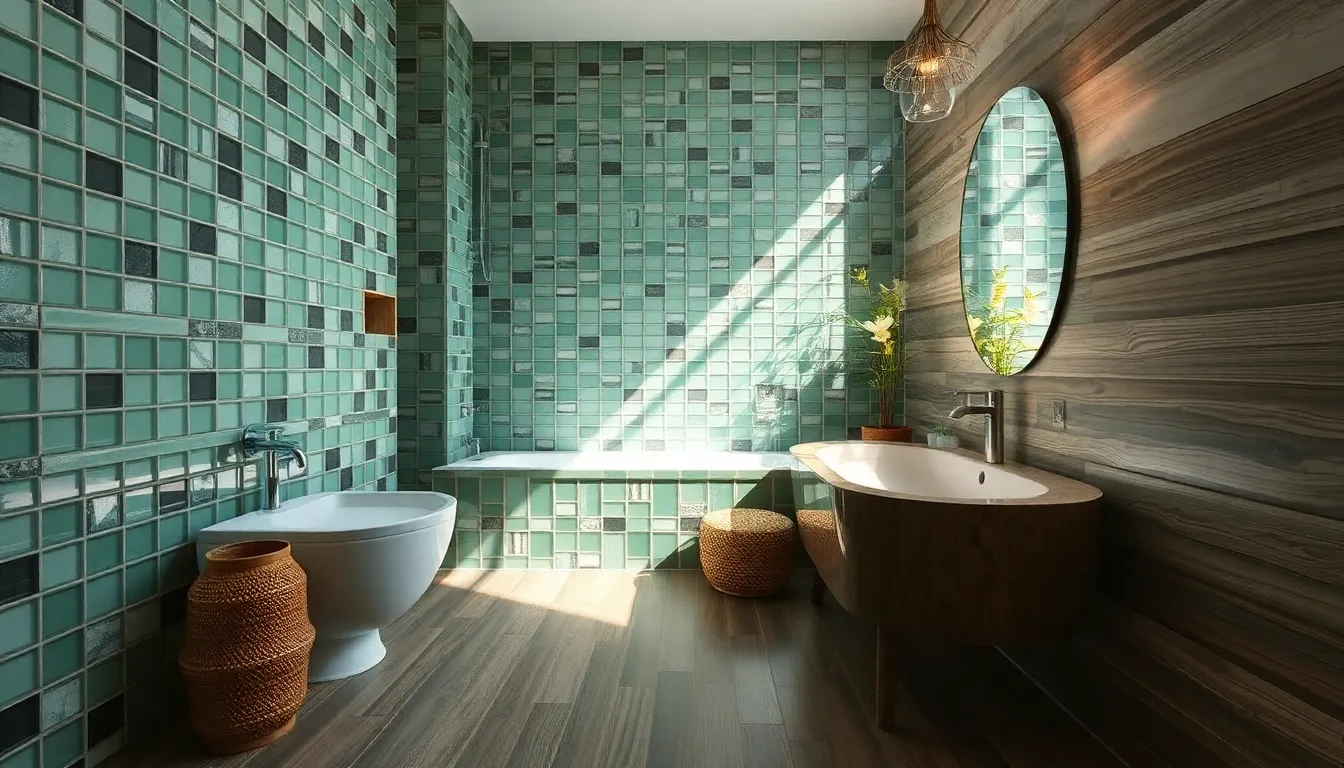
We can create beautiful, sustainable bathrooms while reducing our environmental impact through thoughtful flooring material choices. These eco-conscious options combine durability with responsible sourcing and manufacturing processes.
Recycled Material Options
Recycled glass tiles transform waste into stunning bathroom surfaces that rival traditional materials. ModRocks and similar brands create spa-like ambiances using entirely recycled glass content, dramatically reducing landfill waste while delivering exceptional water resistance. We recommend these tiles for shower walls and accent areas where their reflective properties enhance natural light.
Terrazzo floors with recycled aggregates offer timeless elegance through sustainable innovation. Manufacturers now incorporate recycled glass chips, marble fragments, and ceramic pieces into terrazzo mixtures, creating unique patterns while diverting waste from landfills. This option provides superior durability for high-traffic bathroom areas.
Recycled ceramic tiles deliver traditional ceramic benefits through environmentally responsible manufacturing. Many leading tile manufacturers now produce ceramic options containing 20-40% recycled materials, maintaining the low-VOC properties and extended lifespans we expect from ceramic flooring. These tiles offer identical performance to traditional ceramics while supporting circular economy principles.
Sustainable Flooring Choices
Bamboo flooring stands out as nature’s fastest-growing flooring solution, reaching harvest maturity in just 3-5 years compared to hardwood’s decades-long growth cycle. This renewable resource provides natural water resistance and durability for bathroom environments, though we should note its susceptibility to scratching requires careful maintenance. Strand-woven bamboo varieties offer enhanced moisture protection for humid bathroom conditions.
Cork flooring brings natural antimicrobial properties and exceptional comfort to bathroom spaces. Harvested from cork oak bark without harming trees, this renewable material naturally resists mold and mildew while providing warm, cushioned surfaces underfoot. We appreciate cork’s sound-dampening qualities and thermal insulation properties in multi-story bathroom installations.
Reclaimed wood transforms salvaged timber into unique bathroom flooring with rich historical character. This option prevents deforestation while diverting usable wood from demolition waste streams, creating one-of-a-kind floors with authentic weathering and patina. Proper sealing becomes essential for bathroom moisture protection with reclaimed wood installations.
Low-VOC Flooring Products
Linoleum flooring offers natural composition through linseed oil, cork dust, and jute backing materials that emit minimal volatile organic compounds. This antimicrobial surface naturally resists bacteria growth while providing excellent water resistance for bathroom environments. We find linoleum’s biodegradable properties and 40-year lifespan make it an exceptional sustainable choice.
Natural ceramic tiles maintain indoor air quality through their inherently low-VOC manufacturing processes and non-toxic surface treatments. These tiles emit virtually no harmful chemicals after installation, contributing to healthier bathroom environments. Water-based sealers and glazes further reduce VOC emissions during the installation process.
Low-emission vinyl products now meet strict environmental standards through improved manufacturing techniques and material compositions. Third-party certifications like FloorScore and GREENGUARD Gold identify vinyl flooring options with minimal chemical emissions, ensuring bathroom air quality remains uncompromised while maintaining the durability and water resistance we need.
Installation Considerations for Bathroom Floors
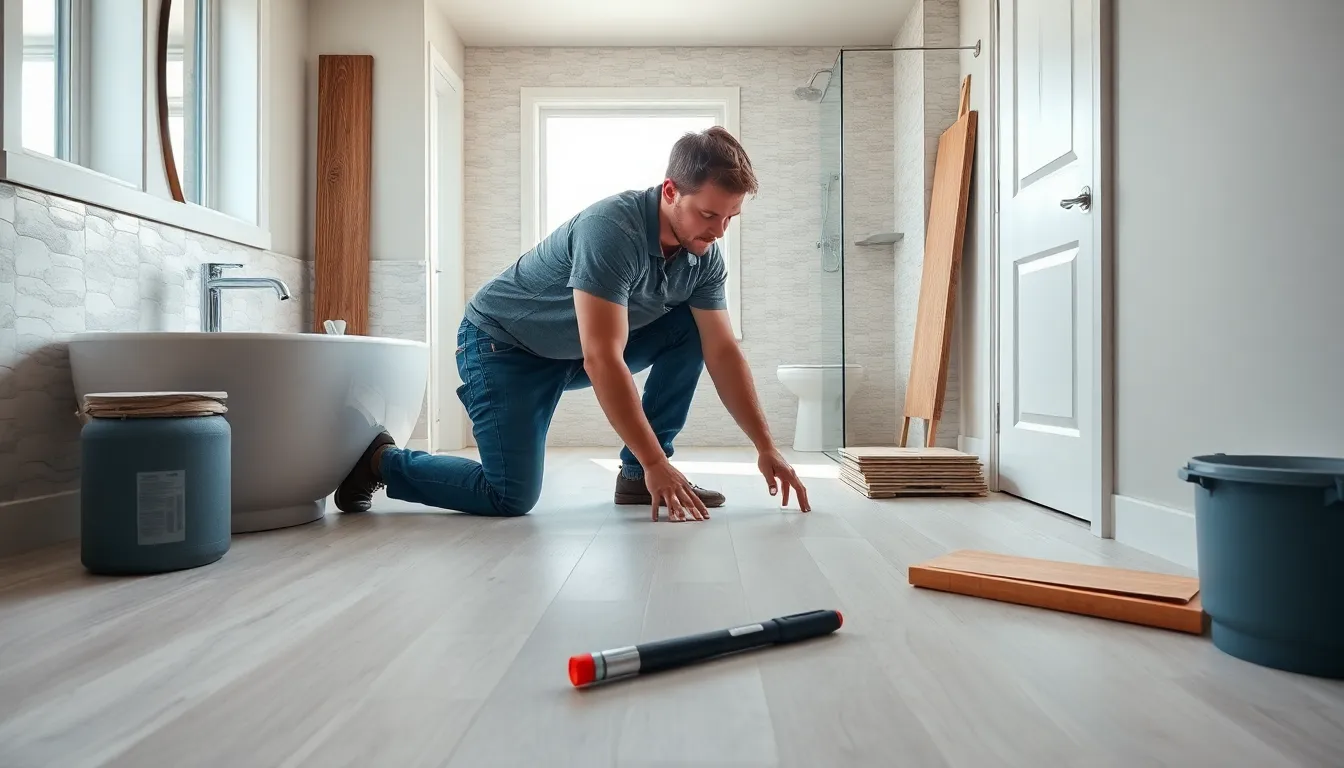
Installing bathroom flooring requires careful planning and attention to exact requirements that differ from other rooms. We need to address critical factors that ensure long-lasting, water-resistant results.
Subfloor Preparation Requirements
Leveling your subfloor creates the foundation for successful bathroom flooring installation. We must ensure the surface is completely even to prevent uneven flooring that can crack or shift over time. Using a long level or straight edge, we can identify any high or low spots that need correction.
Cleaning the subfloor thoroughly removes debris and old adhesives that can interfere with proper installation. We recommend scraping away any remaining materials and vacuuming all dust particles. Stubborn adhesive residue may require chemical removers or mechanical scraping tools.
Verifying subfloor dryness prevents future moisture problems that can damage your new flooring. We should check moisture levels using a moisture meter and allow adequate drying time if readings exceed manufacturer recommendations. Any signs of water damage or rot must be addressed before proceeding with installation.
Moisture Barrier Installation
Installing a moisture barrier serves as crucial protection against water damage and rot in bathroom environments. We need to position this barrier according to manufacturer instructions, typically beneath the underlayment layer. This critical step prevents moisture from seeping through to the subfloor.
Applying the barrier correctly requires attention to seams and edges where water might penetrate. We recommend overlapping seams by at least 6 inches and sealing all joints with appropriate tape or sealant. Special attention should be paid to areas around fixtures and transitions.
Choosing the right barrier type depends on your exact flooring material and bathroom conditions. We typically use plastic sheeting for basic protection or specialized vapor barriers for areas with extreme moisture exposure.
Professional vs DIY Installation
Hiring a professional installer ensures precise installation and reduces the risk of costly errors, especially for complex layouts or large bathroom areas. We find that professionals bring specialized tools and experience that can save time and prevent common mistakes. Their expertise becomes particularly valuable when dealing with intricate tile patterns or challenging room configurations.
Choosing DIY installation works well for smaller projects or homeowners with previous flooring experience. We recommend this approach for straightforward installations using vinyl plank flooring or peel-and-stick options. DIY projects can be cost-effective but require careful planning, proper tools, and realistic assessment of your skill level.
Evaluating project complexity helps determine the best installation approach for your exact situation. We suggest considering factors like bathroom size, flooring material complexity, plumbing obstacles, and your available time before making this decision.
Conclusion
Choosing the perfect bathroom flooring doesn’t have to be overwhelming when you understand your options and priorities. We’ve explored everything from timeless ceramic tiles to innovative luxury vinyl planks and sustainable eco-friendly materials that meet diverse needs and budgets.
Remember that the best flooring choice balances your lifestyle requirements with your aesthetic vision. Whether you’re drawn to the elegance of natural stone or the practicality of waterproof vinyl we’ve shown you answers that deliver both style and performance.
Take time to evaluate your exact bathroom conditions including moisture levels traffic patterns and installation preferences. With proper planning and the right material selection you’ll create a beautiful durable floor that enhances your daily routine for years to come.
Frequently Asked Questions
What is the best flooring material for bathrooms?
Ceramic and porcelain tiles are considered the gold standard for bathroom flooring due to their exceptional water resistance, durability, and endless design possibilities. They can withstand moisture, temperature changes, and heavy foot traffic while maintaining their appearance over time. These materials offer the perfect combination of functionality and aesthetic appeal for bathroom environments.
Are luxury vinyl planks suitable for bathroom use?
Yes, waterproof luxury vinyl planks (LVP) are excellent for bathrooms. They offer exceptional moisture resistance, preventing warping and mold growth. LVP provides easy installation, noise reduction, and comes in various wood-look and stone-look styles that replicate natural materials without the maintenance concerns, making them a practical and stylish choice.
Can I install hardwood flooring in my bathroom?
Traditional hardwood isn’t recommended for bathrooms due to moisture concerns. However, alternatives like bamboo flooring (naturally moisture-resistant), cork flooring (comfortable and antimicrobial), or water-resistant engineered hardwood can provide the warmth and beauty of wood while better handling bathroom conditions when properly sealed and maintained.
What are the most budget-friendly bathroom flooring options?
The most affordable options include laminate flooring ($1-4 per sq ft), vinyl sheet flooring ($0.50-3 per sq ft), and peel-and-stick tiles ($0.50-6 per sq ft). These materials offer water resistance, easy DIY installation, and attractive designs that can create stylish results without overspending on your bathroom renovation project.
How can I make my small bathroom appear larger with flooring?
Use light-colored flooring like ceramic tiles or natural stone to reflect light and create spaciousness. Install tiles diagonally in patterns like chevron or herringbone to enhance space perception. Consider continuous flooring flow from adjacent rooms to eliminate visual barriers and create seamless transitions that make the space feel larger.
What eco-friendly flooring options are available for bathrooms?
Sustainable options include bamboo (rapidly renewable), cork (antimicrobial and comfortable), recycled glass tiles, and terrazzo with recycled aggregates. Low-VOC products like natural linoleum and ceramic tiles improve indoor air quality. Reclaimed wood and recycled ceramic tiles also offer environmentally responsible choices that reduce waste and environmental impact.
Do I need professional installation for bathroom flooring?
Professional installation is recommended for complex projects, natural stone, or when installing moisture barriers and subfloor preparation. DIY installation may work for simpler projects like peel-and-stick tiles or basic vinyl planks, but requires careful planning and skill assessment. Professional installation ensures precision, proper waterproofing, and warranty protection.
What preparation is needed before installing bathroom flooring?
Proper subfloor preparation is crucial, including ensuring a level surface, thorough cleaning, and moisture verification. Installing a moisture barrier is essential to protect against water damage. The subfloor must be structurally sound and completely dry before installation begins to prevent future issues like warping or mold growth.
